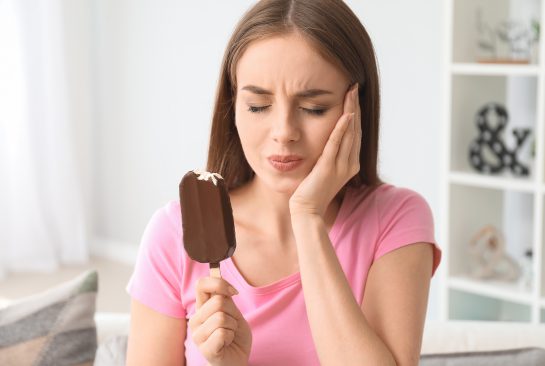- SHOWCASE

Throbbing Gum Pain: What it Means and When to See a Dentist
Throbbing gum pain is more common than you may expect, however it can still be distressing and extremely uncomfortable. In addition to your discomfort, throbbing gum pain also unfortunately usually indicates underlying dental health issues that require medical attention. Symptoms vary from patient to patient and can range from a dull ache to a sharp, stabbing sensation, with other common symptoms including swelling, redness and sensitivity in the gums.
Common Causes of Throbbing Gum Pain
Gum Disease and Infections
Gum disease is one of the most common causes of throbbing gum pain. Gum disease affects most people, to various extents, at some point in their lives, and is predominantly caused by poor dental hygiene and avoiding the dentist. In these instances, bacteria builds up underneath the gum line, resulting in inflammation and infection. Symptoms of gum disease can include bleeding gums, redness, swelling and sensitivity, as well as bad breath.
In its early stages, gum disease may resolve by itself with good dental hygiene and a visit to the hygienist. However, gum disease without medical attention can progress quickly into periodontitis. Periodontal disease can result in more pain, with symptoms that are more difficult to treat. It is characterised by deep pockets between the teeth and gums, persistent bad breath, heightened sensitivity and soreness, and can result in receding gums and potential tooth loss.
Dental Abscesses
Dental abscesses are another common cause of throbbing gum pain. An abscess is a pocket of pus that can build up at different areas around the tooth as a result of a bacterial infection. Some abscesses occur at the tip of the tooth root whilst others occur in the gums at the side of a tooth root.
Abscesses can be very painful. They can cause redness and soreness in the mouth, sensitivity, and swelling in the face or jaw. It is important that you visit your dentist immediately to prevent the symptoms from worsening and to avoid further complications, as the infection can spread to other parts of the body. Your dentist can drain the pus, repair the tooth or carry out an extraction as necessary.
Miscellaneous Dental Issues
Poor dental hygiene and other dental health concerns can cause throbbing gum pain, as can canker sores. These are small, painful ulcers which can be caused by stress, an injury to the mouth, or a weakened immune system. Canker sores are usually white or yellow in colour and surrounded by redness. They typically disappear within one to two weeks; however, if the pain is persistent or does not go away in this time, or you have recurring canker sores, it is important to visit your dentist.
Brushing your teeth too hard or incorrect flossing techniques can also be a cause of throbbing gum pain and other dental issues, so it is important to use the correct toothbrush or appliance and seek advice on best flossing practices.
Bruxism (teeth grinding or clenching), also puts added pressure on the gums, which can result in throbbing gum pain, discomfort and other problems. It can cause increased wear and tear of the teeth and pain in other parts of the face including the jaw. Although bruxism is more common in children it can be seen in adults as well, and you should speak to your dentist for advice on how to alleviate symptoms and reduce grinding.
When to Consult a Dentist
Severity and Duration of Pain
If you are suffering from throbbing gum pain that does not go away with the use of over-the-counter analgesics, it is important that you speak to your dentist as soon as possible. Pain that does not subside is usually indicative of a serious dental health complication and early detection and treatment can help to ensure a successful outcome. Avoiding the dentist could result in tooth loss and is never recommended.
Accompanying Symptoms
Other symptoms accompanying throbbing gum pain should not be ignored, as they could indicate a serious dental complication. These include facial swelling, which may point to an infection or abscess that requires immediate treatment. Fever alongside throbbing gum pain also usually indicates an infection and will most likely require a course of antibiotics. These are serious symptoms which require urgent dental care before they escalate.
Most people will experience bleeding gums to some extent during their lives, especially after brushing. While not always serious in isolation, bleeding gums alongside throbbing gum pain can be a sign of gum disease. Although it may be resolved with good dental hygiene, it is advised to visit the dentist before symptoms progress. Receding gums should also not be ignored, and may be addressed by a hygienist carrying out a thorough clean of your teeth and gums to remove bacteria, including beneath the gum line.
Managing Throbbing Gum Pain at Home
Immediate Pain Relief
To manage throbbing gum pain at home, several methods can provide immediate relief:
- Warm or cold compresses: use either, or alternate between the two
- Rinse your mouth with salt water: simply add half a teaspoon of salt in a cup of warm water, swish the solution in your mouth for 30 seconds, and then spit it out to remove food particles and reduce bacteria in the mouth
- Herbal remedies: clove oil, turmeric mixed with water to form a paste, and boiled and cooled tea bags all provide anti-inflammatory properties when applied directly in the mouth to the problem area
- Over-the-counter analgesics: aspirin, paracetamol, ibuprofen and oral anaesthetic gels can help ease pain and discomfort quickly
Throbbing gum pain can be alarming. If you are experiencing symptoms that don’t subside, it is always advised to visit your dentist as soon as possible for professional treatment and to prevent further health complications.







